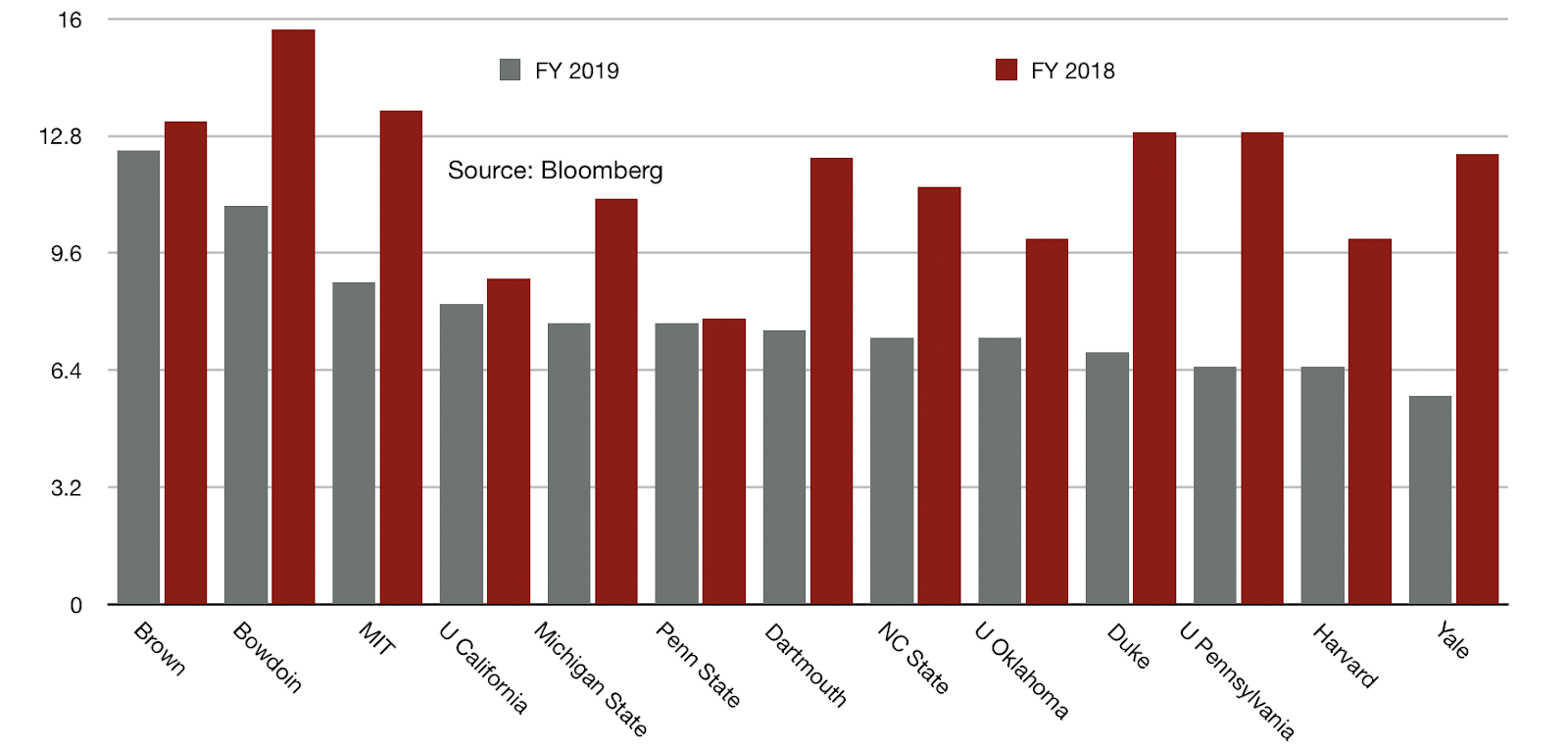All-Weather Investment Leaders: We Need Them Now!
by charles | Comments are closed02/10/2020
We’ve had a remarkable run in the institutional asset-management biz. Good enough to camouflage a lot of mismanagement and sub-optimal decisions.
But we all know that there is trouble ahead and that sooner or later there’s going to be a reckoning.
When things fall apart again, will your foundation or family office be managed by experienced, agile leaders who can cope? Will they keep cool heads when others are losing theirs?
A few years ago an endowment CIO told me: “The board hired us [investment staff] after the 2008 crash because they realized that they never fully understood what they had in their portfolio and there was no one on the inside who could expose and explain the risks.”
“The consultants at the time met with the board once a quarter and kept telling the trustees that everything was fine until our portfolio fell off a cliff.”
The Reckoning
Are there new bubbles about to burst? Here are two possibilities; the unprecedented growth in index vehicles, and the stampede into private equity funds.
The Wall Street Journal reported late last year that the value of US index equity funds had just surpassed US actively managed funds by $4.27 trillion to $4.25 trillion. The Investment Company Institute disputes the Morningstar data, but the growth and appeal of indexing is undeniable.
Who can resist the allure of cheap and easy index funds and ETFs? From 2009 to 2019 the S&P returned a beguiling 11.27 percent annualized, excluding dividend reinvest, and indexers could do no wrong.
Unfortunately, bull markets breed short memories. Few recall that in the prior decade from 1998 to 2009, the S&P actually lost money, delivering a negative 2.72 percent. (Falling a calamitous 55 percent in the final two years, September 2007 to March 2009.)
As for private equity, PitchBook Data calculates that over the last ten years more than three trillion dollars has flowed into private equity and venture capital funds worldwide.
This despite the fact that since 2005, the returns from these illiquid funds have been little better than liquid public market performance.
Some of the best investors in the business have taken notice and are preparing for the possibility of a collapse.
Read More »A Dazzling Decade with Trouble Ahead
by charles | Comments are closed12/12/2019
It’s hard to make predictions – especially about the future.
—Robert Storm Petersen, Danish cartoonist, writer, humorist
London calling
Reporter Chris Flood at the Financial Times ran an article a few weeks ago that parsed our latest endowment performance report and pounced on the fact that that none of the sixty funds we featured performed as well as Vanguard’s VFIAX, a large-cap U.S. equity fund, over the last 10 years.
Our newsletter gave an early peek at endowment investment performance for fiscal 2019, including a ranking by 10-year returns.
The VFIAX returned 14.7 percent net of fees for the decade while the top 10-year endowment investor on our list was Paula Volent at Bowdoin College, who racked up an excellent 12.0 percent.
Mr. Flood’s observation makes a good story-hook but, comparing diversified endowment or foundation portfolios to the VFIAX – or to any similar pure-play equity index makes little sense in the real world.
Retrospectively (looking backwards from 2019), placing all your chips on a cheap equity-only index fund looks like genius, but prospectively (forwards from 2009) it would have been insane for any prudent institutional investor.
Endowments and foundations are long-term global investors with horizons extending out fifty, a hundred years and more, and the trustees and CIOs build portfolios to last for generations.
The job of CIO at an endowment or any financial institution is not to beat the VFIAX, but to meet the objectives set by the board who view capital preservation and steady cash flows as paramount.
The sages speak: Omaha vs. New Haven
In our letter we quoted an anonymous board member who was ready to throw up his hands and index his institution’s endowment, thereby avoiding a lot of fees.
We know this board chair and he’s an able and experienced financial exec.
But some bigger and more eminent investors have also taken positions both for and against a passive strategy.
Read More »Performance & Persistence: 1-10 year Endowment Returns
by charles | Comments are closed11/26/2019
Our FY2019 institutional investment update presents the latest one and ten-year returns for sixty endowments.
We consider ten-year returns to be a rigorous and revealing measure of the strength of an institution’s oversight and investment abilities.
Despite rumblings to the contrary, our latest research shows that many nonprofit chief investment officers – and their boards – deliver meaningful value to their institutions.
The road to riches
Most high-performance investment offices on our list have stable boards and long serving CIOs.
It takes years to fully implement a multi-asset, multi-generational investment strategy and altering course mid-stream – a new investment chair? a change in CIOs? – can sap performance for a decade.
We recruit these executives for a living and avidly follow all institutional investment heads managing assets over $1 billion (and many with less), tracking their performance and scrutinizing their abilities.
They may have a down year or two but, as we spotlighted in an earlier report, top chief investment officers stay on top.
And now, on to the table for our fresh-from-the-oven, pre-Thanksgiving performance chart!
Read More »OCIO Growth in 2019: The Party’s Over
by charles | Comments are closed10/29/2019
No one knows exactly when the Southern Cottontail Rabbit diverged from its other 19 (or so) North American Cottontail cousins, becoming its own distinct species of bunny.
In evolution these things just happen.
Similarly, among financial institutions, modern banks seem to have evolved from traditional moneylenders somewhere in northern Italy in the late 14th century. But that fateful development could only be recognized in retrospect.
Our friend John Hirtle, of Hirtle, Callaghan & Co, claims that he (with fellow Goldman Sachs vet Donald Callaghan) birthed the OCIO species in 1988. He’s a very nice (and imposing) man, so we take him at his word.
In any case, there were soon several smallish firms pursuing the OCIO business model in the early 1990s.
The core idea was to offer a diversified and full-discretion money management function to family offices and others who could no longer effectively or affordably do the job in-house (even with the help of traditional trust banking services).
The job was becoming too sophisticated and complex, both conceptually and operationally.
Observing their success, a number of larger firms joined the scrum in the OCIO space and, in a couple of decades we had the OCIO landscape of today, managing not just billions, but trillions of dollars. And reaping proportionate fees therefrom.
We’ve been charting the growth of the OCIO industry for the past decade in our annual OCIO report and the heirs of Hirtle, big and small, seem (mostly) to have flourished.
In our shiny new 2019 report we observe that total OCIO assets grew from $1.98 Trillion to $2.38 Trillion. That’s a year-over-year growth rate of 19 percent.
That’s pretty impressive! But, the AUM increase is not as vigorous as the annual growth over the previous four years (2014 through 2018). And some of the increase represents a “reclassification of assets” at two OCIO providers.
So, three decades into the OCIO era, we’re minded to ask whether the OCIO growth rate may be slowing, maybe even plateauing. Are the OCIO rabbits multiplying faster than the green, green grass of customer money they live on?
Let’s consider the evidence, both statistical and anecdotal.
The hard numbers
Read More »From Russia, with math! Anastasia Titarchuk takes over New York State’s CRF fund
by charles | Comments are closed09/17/2019
Anastasia Titarchuk just moved up to permanent chief investment officer and deputy comptroller of New York State’s $216 billion CRF fund after three years as Deputy CIO and a year as Interim CIO.
NYSCRF is the county’s third-biggest public pension fund after CalPERS and CalSTRS in California.
We have a revealing Q&A with her just below; but first here’s some context about CRF, which doesn’t usually get as much ink as the big West Coast funds.
Investment Performance
Here are the latest multiyear returns for these three mega-pensions and CRF hold its own very well on a comparative basis. (CRF has a non-standard fiscal year, but we have helpfully stated all figures as of June 30, 2019.)
For 2019, CRF tops both the Californians with 7.1 net return.
Over 10 years the New Yorkers were a close second to CalSTRS, with 9.8 percent vs. Chris Ailman’s 10.1 percent.
Investment Performance NYCRF, CalSTRS, CalPERS
[Click “read more” below for charts and complete report]
Only Mr. Ailman at CalSTRS was CIO for a whole decade (now approaching two decades!). Ms. Titarchuk was interim CIO for all of 2019. And, of course, Mr. Meng at CalPERS is the newbie, in office for only the last six months of the 2019 fiscal year.
Funded Status
A very big deal for public pensions is an actuarial number called funded status, which other institutional investors don’t have to think about. The calculation depends on some tricky estimates, and opinions differ about what’s a healthy number. But higher is always better.
A recent Milliman Study of 100 major U.S. pensions found that only 11 have a funded status over 90 percent, and NYSCRF is one of them, with an enviable 94 percent as of 2018.
Good investment performance can help improve this number, but it’s only one factor. Still, a low funded ratio tends to attract attention in a not-good way and can cast a pall over the whole system.
Read More »




